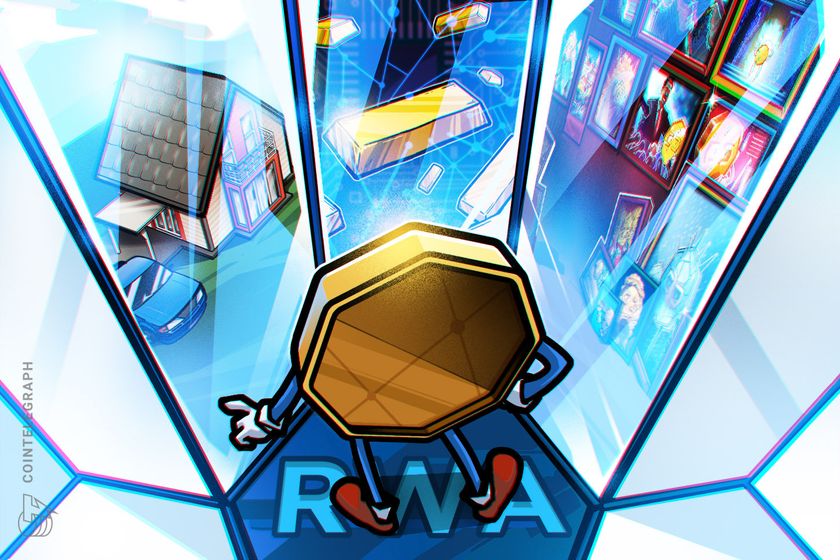
Opinion by: Abdul Rafay Gadit, co-founder of ZIGChain
America’s tariff regime has apparently fueled a worldwide trade war, forcing buyers to discover steady, yield-generating alternate options. A better look reveals that illiquidity, opacity and scalability challenges have plagued world monetary markets for lengthy. They weren’t in nice form anyway, commerce battle or no commerce battle.
Tokenized real-world property (RWAs) have risen to this event — fortunately. For one, they guarantee predictable yields, offering a haven for buyers amid unsure market circumstances and unproductive volatility.
Above all, although, RWAs are a lifeboat for legacy finance, as they improve market liquidity, deliver transparency to opaque markets, and make finance extra democratic. Conventional monetary markets have to combine — not resist — RWAs to remain related within the coming decade.
RWAs to the rescue
In legacy finance, capital’s “computability” happens by means of gradual, costly and unreliable intermediaries like banks. For instance, these entities are primarily unable to rebalance portfolios shortly.
This limits market scope, and customers bear important losses. There are persistent belief points throughout the board, whereas fund managers face immense administrative burdens in dealing with shoppers. The underside line: Everybody suffers, besides the value-sucking go-betweens.
That’s an enormous purpose fundraising in non-public fairness, a key pillar of world monetary markets, declined 24% in 2024, per McKinsey’s report. Likewise, because the SIFMA 2025 Capital Markets Outlook revealed, US fairness issuance has decreased by 0.6% yearly since 2020. Preliminary public choices have been down 8.5% throughout this era.
RWAs repair these. They make portfolio administration extra simple and seamless, with scalable capital deployment even in turbulent markets.
Tokenization automates verifiable transactions, enabling exact, deterministic, trustless economies — turning the established order on its head. It additionally gives buyers with low-risk, low-cost and speedy entry to current and rising world monetary markets.
Current: 5 ways real-world asset tokenization is transforming TradFi
No surprise onchain RWAs elevated 85% to over $15 billion in 2024. And this trend still has momentum. RWAs are poised to remain a top investment category in crypto.
RWAs reached a brand new all-time excessive just lately, surpassing $17 billion, with over 82,000 asset holders. Notably, tokenized non-public credit score is the biggest asset within the RWA business, with over $11 billion in valuation.
It’s clear that buyers selected RWAs within the face of a $10-billion liquidation and common, persistent market volatility. Furthermore, this asset class is making non-public credit score nice once more, laying the inspiration for future monetary markets.
“Good cash” bets on RWAs
JPMorgan, BlackRock, UBS, Citi, Goldman Sachs — all the large names in legacy finance have moved into RWAs. Capital inflows from such “sensible cash” entities helped onchain non-public credit score develop 40% final 12 months, whereas tokenized treasuries surged 179% total.
All this might very nicely be routine diversification and capital enlargement. However funds like Franklin Templeton’s Franklin Onchain US Authorities Cash Fund (FOBXX) and BlackRock’s US greenback Institutional Digital Liquidity Fund (BUIDL) sign a extra long-term motive.
Initiatives like FOBXX and BUIDL are targeted on transforming money markets by means of decrease settlement occasions, simpler liquidity entry, higher buying and selling environments and different enhancements.
They leverage tokenization to introduce novel yield-generating alternatives in historically illiquid markets just like the non-public credit score sector. As knowledge from PricewaterhouseCoopers suggests, this might be a $1.5-trillion disruption. S&P International additionally believes non-public credit score tokenization is the “new digital frontier” that solves liquidity and transparency points.
RWAs are thus rising as a viable, extra profitable various for institutional buyers, who management practically one-fourth of the $450-trillion legacy monetary market. That’s a powerful sufficient waking signal — plus there’s rising demand from “retail” customers (i.e., the remaining three-fourths of the pie).
Retail is the end-game for RWAs
Institutional adoption is great for constructing preliminary consciousness round RWAs. Prefer it or not, their actions transfer the needle. In the long term, nonetheless, particular person retail customers stand to learn most from RWAs.
RWAs make capital markets accessible to grassroots buyers, together with unbanked populations. Fractional possession, as an illustration, lets these with smaller capital holdings get publicity to high-ticket property in any other case reserved for rich household places of work and establishments.
Due to these advantages, retail customers will select RWAs over conventional, unique monetary property and markets. And now it’s a no brainer for them, due to options like social investing platforms, which give customers intuitive, hassle-free entry to novel monetary alternatives.
A number of reviews from Mastercard to Tren Finance and VanEck showcase RWAs’ huge progress potential. It might be wherever between $50 billion and $30 trillion over the subsequent 4 to 5 years.
Widespread retail adoption will drive this progress, and except conventional markets adapt or undertake RWAs, they are going to lose the overwhelming majority of their customers. With institutional and retail capital shifting into this rising sector, it’s genuinely do-or-die for legacy programs.
Strong instruments and platforms that leverage RWAs to bridge the hole between conventional and rising monetary markets can be found now. That makes it a query of intent and precedence greater than anything.
Catch up or grow to be out of date — that’s the message. It’s the wartime arc, because it has been lengthy due. The very best half is that legacy property coming onchain and markets leveraging RWAs can be a win-win for issuers, establishments and retail customers. That’s what the world wants from a monetary standpoint. It’s price all the hassle.
Opinion by: Abdul Rafay Gadit, co-founder of ZIGChain.
This text is for common info functions and isn’t meant to be and shouldn’t be taken as authorized or funding recommendation. The views, ideas, and opinions expressed listed below are the writer’s alone and don’t essentially replicate or symbolize the views and opinions of Cointelegraph.





